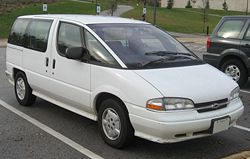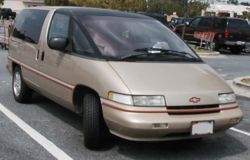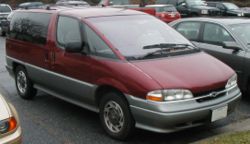- Chevrolet Lumina APV
-
Chevrolet Lumina APV 
Manufacturer General Motors Production 1989–1996 Assembly Tarrytown, New York, United States Successor Chevrolet Venture Class Minivan Body style 3-door van Layout FF layout Platform GM U platform: GMT199 Engine 3.1 L LG6 V6
3.4 L LA1 V6
3.8 L 3800 Series I V6Transmission 3-speed automatic
4-speed automaticWheelbase 109.8 in (2,789 mm) Length 1990–93: 194.2 in (4,933 mm)
1994–96: 191.5 in (4,864 mm)Width 73.9 in (1,877 mm) Height 1990–92: 65.2 in (1,656 mm)
1993–96: 65.7 in (1,669 mm)Curb weight 3599–3899 lb (1632–1769 kg) Related Oldsmobile Silhouette
Pontiac Trans SportThe Chevrolet Lumina APV was a minivan produced by General Motors for the 1990 to 1996 model years. In 1994 the APV was dropped from the name to make the name more consistent with the cars, and it was simply known as Lumina or Lumina Minivan. It is similar to the Pontiac Trans Sport and Oldsmobile Silhouette. In the Chevrolet van lineup, it slotted between the rear-wheel drive entry-level Astro minivan and the Chevy Van.
Contents
Background
General Motors' first attempt at producing a minivan to compete with the Dodge Caravan and Plymouth Voyager, the Chevrolet Astro and its twin, the GMC Safari, failed to make a noticeable dent in Chrysler's almost total dominance of the minivan market in the late eighties, so this second attempt was made.
The Lumina APV was introduced as part of a proposed full line of Chevrolet Lumina vehicles that in the end, included The Lumina Coupe, Lumina Euro Coupe, Lumina Z34 Coupe, Lumina Sedan, Lumina Euro Sedan and Lumina APV Minivan. The "APV" designation stood for "All Purpose Vehicle" and while the vehicle itself was certainly versatile and featured many innovative features, the unusual space age design failed to resonate with many potential minivan buyers. Consumers were ultimately confused by having two different vehicles share the same name as well, so the successor to the Lumina APV was the Chevrolet Venture.
The vehicle shared the unibody frame, and componentry with the GM A platform.
Technology and innovative features
Assembled in the now defunct General Motors Tarrytown, New York assembly facility, these U-body vans consisted of a galvanized steel spaceframe wrapped in composite plastic body panels that were impervious to rust and minor dents and dings, a manufacturing technique developed on the Pontiac Fiero and used extensively on General Motors' Saturn line of vehicles.
The Lumina APV was available with seating for seven, with the five lightweight (34 lb/15 kg) rear seats being individually reconfigurable and removable. In 1994, built-in child seats were added to the option list, which provided the ability to switch two of the rear seats between adult and child seating with the pull of a seat-mounted tab.
The Lumina APV was the only version of the trio to offer a commercial vehicle model that featured a rubber-matted floor in lieu of carpeting, deletion of rear seating and painted plastic panels in place of the side rear glass. Though sharing an identical body, this version was simply known as "APV", with no "Lumina" badging on the exterior of the vehicle.
Included with the optional level ride package, which utilized a compressor and air-pressurized rear shock absorbers to maintain vehicle height regardless of load, was a control panel and air hose kit that allowed the vehicle to be used to inflate tires, air mattresses, sporting equipment and the like.
In 1995, a remote-controlled power sliding door feature was added, a General Motors innovation, which is now available in almost every other minivan today.
For the 1994 and 1995 model years, traction control was available with the 3.8 L V6.
Modest sales success
The design of these minivans was controversial. At the time that the Chevrolet Lumina APV and its siblings were conceived, no one had tried to market a stylish or sporty minivan, and GM felt that that represented a potentially large market segment. They styled these minivans to be lower and sleeker than any of the competing brands on the market. The extremely large, long and sloped windshield and the resultant long distance to the base of the windshield when sitting in the drivers seat made for a disconcerting driving experience until a person could adjust to the "different" proportions. Automotive magazines christened the new minivans "dustbusters" after a household vacuum cleaning appliance that shared a similar side profile.
The first engine in these vans was a meager 3.1 L V6, that produced only 120 hp (89 kW), which was not up to the task of hauling these fairly heavy vehicles around with any authority.
In 1992, the Lumina APV and its siblings received the 170 hp 3.8 L 3800 Series I V6 as an option. The 3.8L provided much better torque and acceleration for the vans, making them the most powerful minivans in production at the time, until Ford's 1996 Windstar 3.8L debuted with 200 hp (150 kW).
In response to criticism (and relatively modest sales) attributable to the vehicles' avantgarde styling, feedback from potential customers, automotive publications, and even chiding in Chrysler Corporation's advertising, in 1994, the Trans Sport and Lumina APV received a facelift, shortening the nose by 3 inches (76 mm) and elimination of the black painted roof and a-pillar "canopy effect" to impart a more conventional look. Additionally a ridge was added to the interior dashboard to lessen the perceived distance to the base of the windshield.
Production of this generation of minivans ceased in 1996, at which time the Tarrytown plant which produced them and which had been in operation since 1900, was shuttered and scheduled for demolition.
The Lumina APV was replaced by the Chevrolet Venture which was a completely new vehicle, with conventional steel unibody construction and extremely conventional styling which purposely aped the class-leading Dodge Caravan and Plymouth Voyager.
Year-to-year changes
1991
- Customer complaints regarding glare reflected on the interior of the windshield from the massive expanse of dashboard led to the addition of black carpeting in lieu of the more reflective plastic used in the previous year.
1992
- Newly available for 1992 was GM's 3800 Series I 170 hp (130 kW) V6 engine coupled with a 4T60-E 4-speed electronically controlled automatic transmission.
- The cowl-mounted fixed radio antenna mast was eliminated, and an integrated roof antenna was installed, sandwiched between the roof and the headliner.
- Side view mirrors were changed to the folding type and were enlarged to provide better rear-ward visibility.
- Brakes were enlarged and anti-lock brakes (ABS) was added as standard equipment.
1993
- A remote controlled power sliding side door was announced for 1993, but failed to actually make it into production for another two years.
- A redesigned center console was added this year with revamped, larger climate controls, a large storage cubby and a large storage bin at its base.
- The "LUMINA APV" badges were entirely removed from the doors; this happened with the 1994 facelift as well until GM entirely discontinued Lumina APV production after 1996.
1994
- The exterior styling was revamped, three inches (76 mm) were trimmed off the nose, headlights taken from the Pontiac Bonneville were installed and the "canopy-effect" black painted forward section of the roof and a-pillars was changed to body color, all in an effort to make the vehicle seem more like its conservatively styled competitors.
- In an effort to lessen the perceived distance to the base of the windshield, a ridge was added to the interior dash finishing panel.
- A remote-controlled power sliding door became available as an option.
- Built-in child seats for the second row became available as an option.
- A traction control system became available as an option.
- Rear deep-tinted windows now featured a darker tint than previously used.
- A driver's side airbag became standard equipment.
- A Third brake light was installed. This was an interesting light because, it was below the left and right tail lights, when it is supposed to be above the main tail lights.
1995
- Automatic power door locks that engaged/disengaged with the transmission shifting into or out of "park" added as a standard feature of the power door lock option package.
1996
- Final year of production. The APV was replaced by the Chevrolet Venture.
- Both the 3.1 and 3.8 L V6 engines were dropped, and the 3.4 L LA1 V6 became the only engine available with 180 hp (130 kW) and 205 ft*lb of torque.
- Traction control dropped as an option.
External links
« previous – Chevrolet, a division of General Motors, light truck timeline, United States market, 1980s–present Type 1980s 1990s 2000s 2010s 0 1 2 3 4 5 6 7 8 9 0 1 2 3 4 5 6 7 8 9 0 1 2 3 4 5 6 7 8 9 0 1 2 Compact crossover Mid-size crossover Equinox Equinox Full-size crossover Traverse Compact SUV Tracker Tracker Mid-size SUV S-10 Blazer Blazer TrailBlazer Full-size SUV K5 Blazer Blazer Tahoe Tahoe Tahoe Suburban Suburban Suburban Suburban SUT Avalanche Avalanche Coupe utility El Camino SSR Compact pickup LUV S-10 S-10 Mid-size pickup Colorado Full-size pickup C/K C/K Silverado Silverado Minivan Lumina APV Venture Uplander Van Astro Astro Van Express Beauville Categories:- Chevrolet vehicles
- Minivans
- Front wheel drive vehicles
- 1990s automobiles
- Motor vehicles manufactured in the United States
- Vehicles introduced in 1989
Wikimedia Foundation. 2010.


